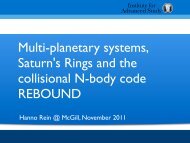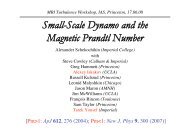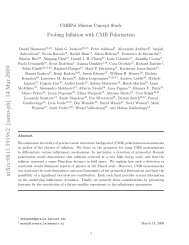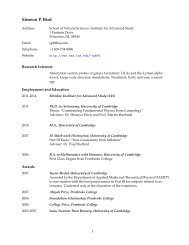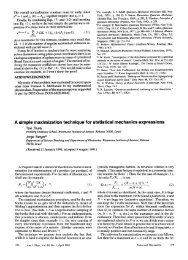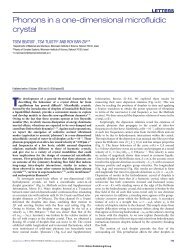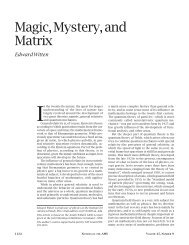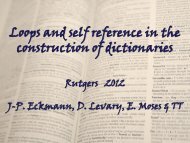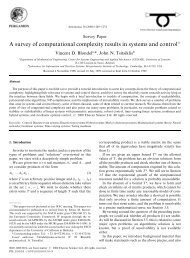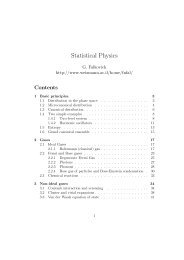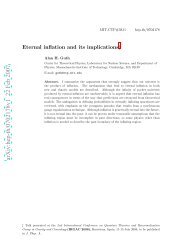Introduction to String Theory and D–Branes - School of Natural ...
Introduction to String Theory and D–Branes - School of Natural ...
Introduction to String Theory and D–Branes - School of Natural ...
You also want an ePaper? Increase the reach of your titles
YUMPU automatically turns print PDFs into web optimized ePapers that Google loves.
with ˜ Φ = Φ−Φ0, Looking at the part involving the Ricci scalar, we see that we have the form <strong>of</strong> the st<strong>and</strong>ard<br />
Einstein–Hilbert action (i.e., we have removed the fac<strong>to</strong>r involving the dila<strong>to</strong>n Φ), with New<strong>to</strong>n’s constant<br />
set by<br />
κ ≡ κ0e Φ0 = (8πGN) 1/2 . (102)<br />
The st<strong>and</strong>ard terminology <strong>to</strong> note here is that the action (96) written in terms <strong>of</strong> the original fields is<br />
called the “string frame action”, while the action (101) is referred <strong>to</strong> as the “Einstein frame action”. It<br />
is in the latter frame that one gives meaning <strong>to</strong> measuring quantities like gravitational mass–energy. It is<br />
important <strong>to</strong> note the means, equation (99), <strong>to</strong> transform from the fields <strong>of</strong> one <strong>to</strong> another, depending upon<br />
dimension.<br />
2.14 A Quick Look at Geometry<br />
Now that we are firmly in curved spacetime, it is probably a good idea <strong>to</strong> gather some concepts, language<br />
<strong>and</strong> <strong>to</strong>ols which will be useful <strong>to</strong> us in many places later on.<br />
2.14.1 Working with the Local Tangent Frames<br />
We can introduce “vielbeins” which locally diagonalize the metric 5 :<br />
gµν(x) = ηabe a µ(x)e b ν(x).<br />
The vielbeins form a basis for the tangent space at the point x, <strong>and</strong> orthonormality gives<br />
e a µ (x)eµb (x) = η ab .<br />
These are interesting objects, connecting curved <strong>and</strong> tangent space, <strong>and</strong> transforming appropriately under<br />
the natural groups <strong>of</strong> each. It is a covariant vec<strong>to</strong>r under general coordinate transformations x → x ′ :<br />
<strong>and</strong> a contravariant vec<strong>to</strong>r under local Lorentz:<br />
e a µ → e ′a µ = ∂xν<br />
∂x ′µ ea ν ,<br />
e a µ (x) → e′a µ (x) = Λab(x)e b µ (x) ,<br />
where Λ a b(x)Λ c d(x)ηac = ηbd defines Λ as being in the Lorentz group SO(1, D−1).<br />
So we have the expected freedom <strong>to</strong> define our vielbein up <strong>to</strong> a local Lorentz transformation in the<br />
tangent frame. In fact the condition Λ is a Lorentz transformation guarantees that the metric is invariant<br />
under local Lorentz:<br />
gµν = ηabe ′a<br />
µe ′b<br />
ν . (103)<br />
Notice that we can naturally define a family <strong>of</strong> inverse vielbiens as well, by raising <strong>and</strong> lowering indices<br />
in the obvious way, e µ a = ηabg µν e b ν. (We use the same symbol for the vielbien, but the index structure will<br />
make it clear what we mean.) Clearly,<br />
g µν = η ab e µ ae ν b , e µ<br />
b ea µ = δ a b . (104)<br />
In fact, the vielbien may be thought <strong>of</strong> as simply the matrix <strong>of</strong> coefficients <strong>of</strong> the transformation (that always<br />
exists, by the Equivalence Principle) which finds a locally inertial frame ξ a (x) from the general coordinates<br />
x µ at the point x = xo:<br />
e a µ(x) = ∂ξa (x)<br />
∂x µ<br />
5 “Vielbein” means “many legs”, adapted from the German. In D = 4 it is called a “vierbein”. We shall <strong>of</strong>fend the purists<br />
henceforth <strong>and</strong> not capitalise nouns taken from the German language in<strong>to</strong> physics, such as “ansatz”, “bremsstrahlung” <strong>and</strong><br />
“gedankenexperiment”.<br />
28<br />
<br />
<br />
<br />
x=xo<br />
.



